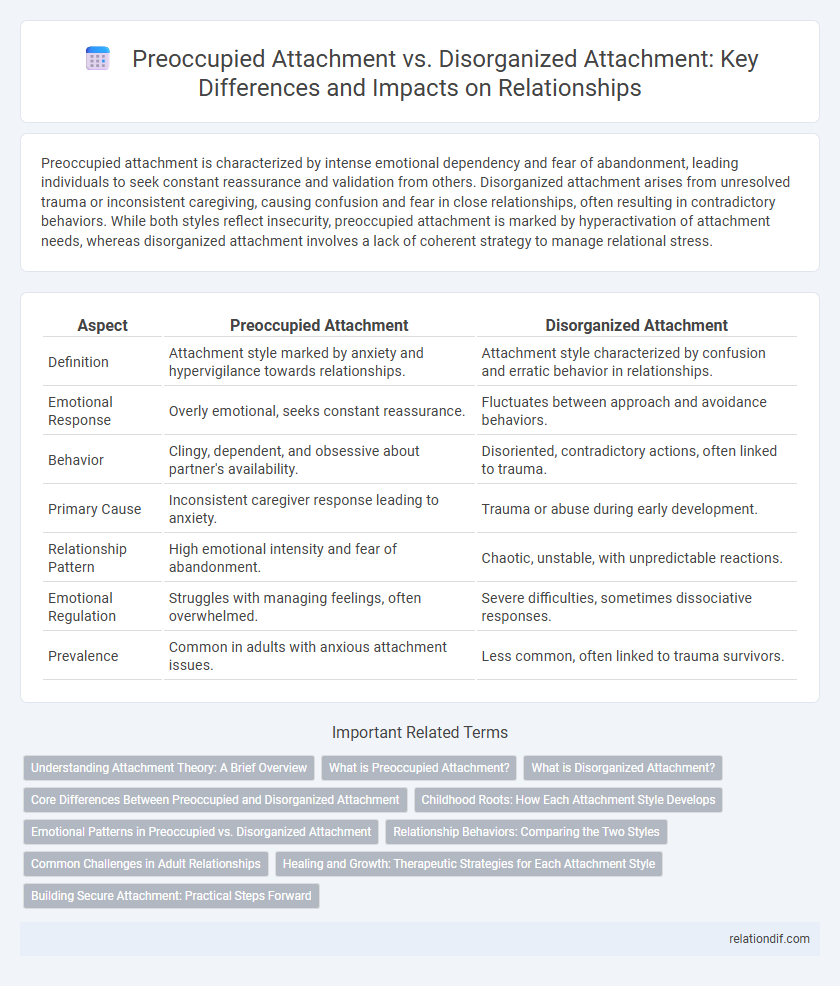Preoccupied attachment is characterized by intense emotional dependency and fear of abandonment, leading individuals to seek constant reassurance and validation from others. Disorganized attachment arises from unresolved trauma or inconsistent caregiving, causing confusion and fear in close relationships, often resulting in contradictory behaviors. While both styles reflect insecurity, preoccupied attachment is marked by hyperactivation of attachment needs, whereas disorganized attachment involves a lack of coherent strategy to manage relational stress.
Table of Comparison
| Aspect | Preoccupied Attachment | Disorganized Attachment |
|---|---|---|
| Definition | Attachment style marked by anxiety and hypervigilance towards relationships. | Attachment style characterized by confusion and erratic behavior in relationships. |
| Emotional Response | Overly emotional, seeks constant reassurance. | Fluctuates between approach and avoidance behaviors. |
| Behavior | Clingy, dependent, and obsessive about partner's availability. | Disoriented, contradictory actions, often linked to trauma. |
| Primary Cause | Inconsistent caregiver response leading to anxiety. | Trauma or abuse during early development. |
| Relationship Pattern | High emotional intensity and fear of abandonment. | Chaotic, unstable, with unpredictable reactions. |
| Emotional Regulation | Struggles with managing feelings, often overwhelmed. | Severe difficulties, sometimes dissociative responses. |
| Prevalence | Common in adults with anxious attachment issues. | Less common, often linked to trauma survivors. |
Understanding Attachment Theory: A Brief Overview
Preoccupied attachment manifests as anxiety about relationships, characterized by excessive concern over approval and abandonment, often rooted in inconsistent caregiving. Disorganized attachment combines contradictory behaviors such as seeking comfort and displaying fear toward the caregiver, typically resulting from trauma or neglect. Both attachment styles highlight the critical role of early caregiver interactions in shaping emotional regulation and interpersonal dynamics.
What is Preoccupied Attachment?
Preoccupied attachment is characterized by excessive dependency on others for validation and a persistent fear of abandonment, often leading to emotional hyperactivation and difficulty regulating feelings. Individuals with preoccupied attachment tend to have a negative self-view while idealizing others, resulting in anxious and clingy behaviors in relationships. This attachment style originates from inconsistent caregiving during childhood, causing confusion and heightened sensitivity to perceived relational threats.
What is Disorganized Attachment?
Disorganized attachment is characterized by a lack of a clear attachment strategy, often resulting from inconsistent or frightening caregiving, leading to behaviors that appear contradictory or confused in the child. This attachment style is linked to increased risks of emotional dysregulation, anxiety, and difficulties in forming stable relationships later in life. Unlike preoccupied attachment, which involves hyperactivation of attachment behaviors due to anxiety and fear of rejection, disorganized attachment reflects a breakdown in attachment organization caused by trauma or neglect.
Core Differences Between Preoccupied and Disorganized Attachment
Preoccupied attachment is characterized by intense anxiety and hyper-focus on relationships, driven by fears of abandonment and seeking validation, whereas disorganized attachment involves conflicting behaviors and a lack of coherent strategy for dealing with stress due to trauma or neglect. Preoccupied individuals often display clinginess and emotional volatility, while disorganized attachment manifests in unpredictable responses, combining approach and avoidance behaviors. The core difference lies in the underlying mechanisms: preoccupied attachment stems from inconsistent caregiving leading to heightened dependency, whereas disorganized attachment arises from fear and confusion caused by caregiving that is frightening or frighteningly unpredictable.
Childhood Roots: How Each Attachment Style Develops
Preoccupied attachment often develops from inconsistent caregiving during childhood, where a caregiver's unpredictable availability leads children to become overly focused on seeking approval and closeness. Disorganized attachment arises from traumatic or frightening experiences, such as abuse or neglect, causing children to simultaneously crave and fear attachment figures, resulting in confusion and difficulty regulating emotions. Both styles are rooted in early interactions with caregivers that fail to provide reliable security and emotional support.
Emotional Patterns in Preoccupied vs. Disorganized Attachment
Preoccupied attachment is characterized by heightened emotional sensitivity and intense anxiety about relationships, often leading to hypervigilance and persistent worry about abandonment. In contrast, disorganized attachment presents contradictory emotional patterns, where fear and confusion dominate, causing erratic emotional responses and difficulty self-regulating in interpersonal situations. These distinct emotional patterns influence individuals' relational behaviors, with preoccupied attachment fostering clinginess and disorganized attachment resulting in unpredictable and disoriented interactions.
Relationship Behaviors: Comparing the Two Styles
Preoccupied attachment is characterized by intense emotional dependency and hypervigilance to relationship cues, often resulting in clinginess and fear of abandonment. Disorganized attachment exhibits contradictory behaviors such as approach-avoidance patterns, confusion, and difficulty regulating emotions during interactions. Both styles contribute to instability, but preoccupied attachment centers on seeking reassurance, while disorganized attachment reflects deeper unresolved trauma affecting trust and consistency in relationships.
Common Challenges in Adult Relationships
Adults with preoccupied attachment often struggle with intense fears of abandonment and clinginess, leading to emotional dependency and difficulty maintaining boundaries. Those with disorganized attachment tend to experience confusion and contradictory behaviors in relationships, resulting in mistrust, emotional volatility, and challenges in forming secure bonds. Both attachment styles can cause persistent insecurity and conflict, impacting intimacy and long-term relationship stability.
Healing and Growth: Therapeutic Strategies for Each Attachment Style
Preoccupied attachment benefits from therapeutic strategies centered on building emotional regulation and fostering secure boundaries through cognitive-behavioral therapy and mindfulness practices. Disorganized attachment requires trauma-informed approaches that integrate dialectical behavior therapy (DBT) and somatic experiencing to address fragmented self-perceptions and develop safety within relationships. Both attachment styles respond effectively to consistent therapeutic alliance and validation, which promote healing and facilitate growth toward secure attachments.
Building Secure Attachment: Practical Steps Forward
Preoccupied attachment involves anxiety and hyperactivation of the attachment system, while disorganized attachment is marked by fear and confusion in relationships. Building secure attachment requires consistent emotional availability, clear communication, and establishing predictable routines to foster safety and trust. Therapeutic interventions like attachment-based therapy and caregiver sensitivity training significantly support the shift toward secure attachment patterns.
Preoccupied attachment vs disorganized attachment Infographic

 relationdif.com
relationdif.com